
You are here: Visitor Information > Daphne du Maurier > The Jane Slade Project
You may have heard about our project and wondered what it is all about, so hopefully this will help!
If you are interested in history, literature, commerce or in creating career aspirations for the young, and the not so young, then there should be something here to grab your attention.
The Jane Slade Project is a registered charity with objectives which surround “the support and delivery of education in subjects connected with the operation and construction of marine vessels”. That’s the technical explanation of what we are about, but what follows will make easier reading!
What’s in a name?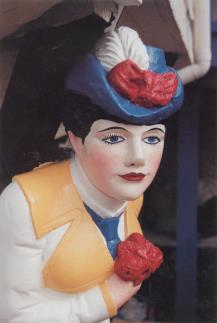
Jane Slade was a real person. She lived in Polruan in the late 1800’s and she certainly didn’t conform with the traditional role of a woman in Victorian society. Jane Slade ran a successful boat builder’s business and she held shares in several ships. She was the first landlady of the Russel Inn on West Street in Polruan, a wedding present from her father in 1832.
Jane’s involvement with the shipyard came about after the death of her husband, who owned the yard and had already named a schooner after his wife. She wasn’t merely an accidental custodian of this business; she took it seriously and had great success in expanding it through the acquisition of neighbouring yards.
This story of commercial success and overcoming gender prejudice would be admired in today’s world, but it is even more significant given that all of this took place at a time when women didn’t have the vote and their property was still considered to be that of their husband.
 The Jane Slade of Polruan
The Jane Slade of Polruan
The Jane Slade was a fruit schooner. These were relatively small vessels but they were built to be very fast for the simple reason that there was no refrigeration in those days. If the fruit didn’t get to its customers quickly, it would rot!
Not surprisingly, there was a rivalry between captains and owners to show who had the fastest vessel. This wasn’t all about professional pride, it was because the first ship in stood the best chance of a good price for its cargo. The Jane Slade was a record holder for the passage from the Azores to Bristol.
Today a ship is designed by naval architects using lots of historic data, computer modelling and simulations. In the days of the original Jane Slade, the design of a fast vessel was in part based on the skill and experience of the boat builder. He would have his own views on the shape of the hull (the ship’s “lines”) and the person who was to captain the vessel would bring his experience to the design of the rig.
modelling and simulations. In the days of the original Jane Slade, the design of a fast vessel was in part based on the skill and experience of the boat builder. He would have his own views on the shape of the hull (the ship’s “lines”) and the person who was to captain the vessel would bring his experience to the design of the rig.
Much of this information would be stored in the head of the builder and his team, so it’s not surprising that local areas had their own style of vessel, renowned for a particular aspect of its performance.
Fowey, at the end of the 19th Century, was known for building particularly fast hulls. One theory for this is the history of piracy in Cornwall. Mevagissey, which is only a short distance from Polruan by sea, was particularly renowned for piracy and for building very fast sailing vessels, which managed to out run the customs vessels. Not surprisingly, the shipbuilders of Mevagissey developed fast hulls, and it is thought that many of them subsequently found work in the boat building yards of Polruan.
The Dauphne Du Maurier connection
Daphne Du Maurier loved Cornwall, particularly the area around the Fowey River. Her love of the area and its history inspired several successful novels; Frenchman’s Creak (based on the Helford River just south of Falmouth), Jamaica Inn (based on a public house on Bodmin moor) and of course Rebecca. The latter is reputedly based on her love of the house ‘Menabilly’ just outside Fowey, I prefer to see it as based on ‘Place’ the ancient house overlooking Fowey Town.
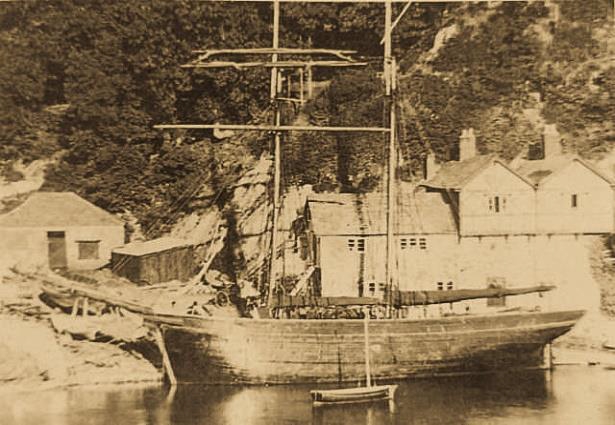 Her first novel, The Loving Spirit, started her literary career, but is far less well known. Once you have spent some time around the streets of Polruan and Fowey, you will have no doubt where that story is based. What won’t be immediately apparent is that the novel owes almost as much to fact as it does to the author’s imagination. It was based on a real character Jane Slade (Janet Combe in the book) and on a fruit schooner, The Jane Slade of Polruan.
Her first novel, The Loving Spirit, started her literary career, but is far less well known. Once you have spent some time around the streets of Polruan and Fowey, you will have no doubt where that story is based. What won’t be immediately apparent is that the novel owes almost as much to fact as it does to the author’s imagination. It was based on a real character Jane Slade (Janet Combe in the book) and on a fruit schooner, The Jane Slade of Polruan.
Du Maurier first visited Fowey as a holiday destination and she learned to sail on the Fowey river in a small dinghy. It was in those early years that she came across the wreck of the Jane Slade, rotting away in Pont Pill (the small inlet of water just north of Polruan, opposite Fowey town).
She was struck by the imposing figurehead of Jane Slade, which was still impressive even with the vessel in the state it was in. This led her to historical research and the rest is … well history!
So, what has all that got to do with marine education in today’s world?
The history and romance of boatbuilding and sailing ships is engaging and we think the story of Jane Slade is inspirational. It shows what can be achieved when opportunity and drive coincide, but there are also some more pragmatic lessons to draw from this story.
In the late 19th Century, Britain had a powerful empire, stretching across the globe. The backbone of this empire was the  fleets of ships and their crews that enforced British rule (the Royal Navy) together with the merchant ships that carried the goods that were at the heart of the trading system that was the Empire. Both were essential parts of the world economy, and thriving commercial ports were located around the whole of the UK coast to support these vessels.
fleets of ships and their crews that enforced British rule (the Royal Navy) together with the merchant ships that carried the goods that were at the heart of the trading system that was the Empire. Both were essential parts of the world economy, and thriving commercial ports were located around the whole of the UK coast to support these vessels.
In the 19th Century, seagoing trade was a very visible part of everyday life, and as a result, was a natural career option for people in cities and rural areas alike. Access to this career was similarly locally based. If you wanted a place on a ship you went to a local port and sought an introduction to a ship owner or captain, seeking to be signed on for an apprenticeship.
Today, there is no empire but commercial sea born traffic is still as important as ever. Over 90% of the world’s goods still travel by sea. One way of measuring the size of this market is to look at the number of tonnes transported multiplied by the number of miles travelled. So here is a big number for you; in 2012 the number of tonne miles for sea transport was 44,000 billion! That’s over 5,000 tonne miles for every person on the planet.
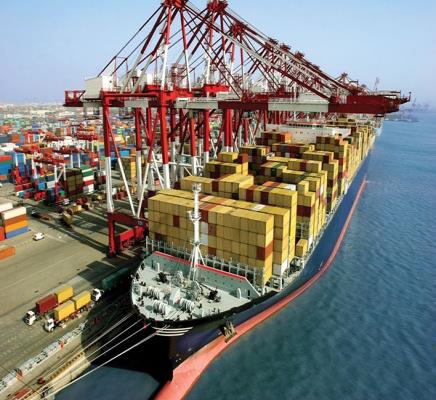 The main difference is that it is now highly industrialised and centred on a small number of huge ports. The smaller local ports have either closed or they have dramatically changed their character. Fowey, for example, retains a small commercial operation for clay ships and a few visiting cruise liners, but otherwise the main sea born traffic is the 6,000 plus private yachts that visit each year.
The main difference is that it is now highly industrialised and centred on a small number of huge ports. The smaller local ports have either closed or they have dramatically changed their character. Fowey, for example, retains a small commercial operation for clay ships and a few visiting cruise liners, but otherwise the main sea born traffic is the 6,000 plus private yachts that visit each year.
An unfortunate consequence of all of this is that, as a nation, we have lost sight of the sea as part of our national life. That means that a career at sea is no longer a natural part of the thought process for most young people. This problem is compounded by the fact that the starting point for many seafarers is no longer an apprenticeship on a local vessel. Instead, it’s a degree level course at a maritime college. The sophistication of this training is a good thing but an unintended consequence is that many young people see this route as being out of their reach.
These factors contribute to the growing national shortage of officer candidates in the merchant navy. Department of Transport forecasts show that in the period between 2016 and 2026, there will be a drop of 7% in UK nationals as ship’s officers. Within the narrower category of deck and engine officers the same projections show a drop of 30%!
What do we plan to do about it?
In summary, we plan to:
1. Build a new Schooner in the spirit of Jane Slade of Polruan, to be used as a tool for maritime education.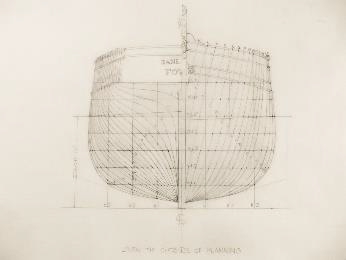
The new vessel will be built at C. Toms and Son in Polruan, close to the site of the yard that built the original vessel. Toms’ yard will build the hull, but we hope to see many of the other local boat builders and engineers involved in the fit out and rigging of the vessel.
Once operational, the vessel will carry commercial cargo and transport passengers. Whilst doing this, we will also carry trainees who will get real life experience of operating a traditional vessel but in doing so they will learn modern skills of seamanship, navigation, cargo handling, passenger management and hotel skills.
2. Create aspiration.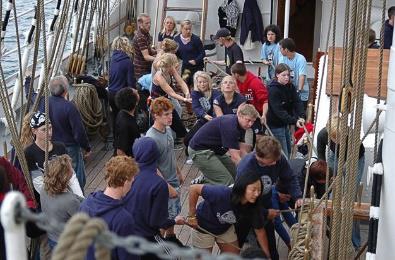 The sea is an important part of our national life and it also offers decent well paid career opportunities.
The sea is an important part of our national life and it also offers decent well paid career opportunities.
We see part of our role as raising the profile of this career amongst young people by partnering with educational and other bodies to get marine careers on their radar. By raising aspiration, we recruit our trainees!
When they leave us, our trainees may head for a career in commercial shipping or in the marine leisure industry. Whichever route they take we hope to have helped light the fire and to have opened the door to opportunity.
3. Partner with maritime colleges so that we can offer our trainees real certificates to demonstrate the skills they acquire and for those certificates to be recognised as part of the entry requirements for maritime colleges. An alternative to GCSE’s and A levels.
to demonstrate the skills they acquire and for those certificates to be recognised as part of the entry requirements for maritime colleges. An alternative to GCSE’s and A levels.
How can you help?
We hope you have found this interesting and that you are supportive of what we are trying to achieve. If you want to help us, then there are lots of opportunities, including:
- Do you want to help us with any of the aspects of running the charity? We are keen to recruit volunteers who will be able to help with everything from administration to fundraising. If you have a particular technical skill that would be appropriate for the project, then please get in touch!
- Are you a potential trainee or do you know someone who is? We have a bit of work to do to raise the £1.5m needed to build the vessel and then get it on the water, but that’s no reason not to put a name down!
- Can you help us connect to educational bodies? That may be making connections with maritime colleges or it may be helping us liaise with mainstream education to raise the profile of a career at sea. Even if people don’t become a trainee, we will be doing our job if it opens their eyes to the potential of a life at sea.
- Do you work in a business that may be interested in sponsoring the project?
We have a number of supporter’s schemes for businesses large and small. We would be delighted to hear from any potential business partner as long as the relationship is consistent with our status as a charity and with our objectives. We hope that businesses with relationships with the maritime industry will be keen to support us, but being part of the maritime industry isn’t a pre-requisite.
- Do you want to become an individual supporter of the project? We also have individual supporter schemes so please get in touch if you are interested.
- If you want to make a donation that would also be very welcome. You can do this by going to www.mydonate.bt.com/charities/thejanesladeproject
Thank you for taking the time to read about us. If you want to hear more then please get in touch using william@janesladeproject.org
The information on Jane Slade came from Helen Doe’s book ‘Jane Slade of Polruan: The Inspiration for Daphne du Maurier’s First Novel’, published by Truran.
© EnjoyFowey. All Rights Reserved




